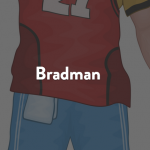Way Out of Bounds
How an ugly incident prompted the Star's Mary Ormsby to tackle locker-room sexism
In 1985, Toronto Star sportswriter Mary Ormsby became one of the first women in the history of the Canadian Football League to report from players’ locker rooms. By then, Ormsby had been in dozens of male athletes’ locker rooms. In her four years on the job, Ormsby, then 25, had learned to accept the reality of scantily clad athletes, both college and professional. Sure, she had run into some lighthearted teasing, but she had always taken it in stride.
Then, on a humid evening last June 16, following a preseason game between the Hamilton Tiger-Cats and the Toronto Argonauts, the harassment took an ugly turn. “I came downstairs, and as soon as I walked into the Ti-Cat dressing room, it exploded,” Ormsby recalls. “The players were screaming so loud the other reporters had to turn off their machines.” But there was more to the yelling than the decibel level. “Players were calling me a fucking slut, fucking cunt, fucking whore, and were performing mock rapes and masturbating themselves. The whole thing went on for 12 or 13 minutes.” At one point, a naked player confronted Ormsby at the locker-room door, refusing to let her out. The three other reporters in the room stood silent and did nothing. Not that Ormsby expected anything: “Why should they stand up for me?” she would say later. “It’s like asking someone to fight my battles for me.” So Ormsby fought her own battles. She stayed on in the locker room, interviewing Ti-Cat safety Paul Bennett and quarterback Tom Porras. To Bennett’s credit, he made several attempts to quiet his teammates and, on one occasion, told them to “act like professionals.” But the abuse continued.
Ormsby left the room in a rage, but with her deadline looming, there was little time to dwell on what had happened. She got her story off well enough. The next day, though, she was at the point of tears. “I refused to do any football for the rest of the week because I was in quite an emotional state.” Still, she called Ti-Cat head coach Al Bruno and told him about the conduct of his players. Bruno immediately apologized and vowed that it would never happen again. CFL policy calls for a 20minute period after each game during which all reporters are allowed in the locker rooms to conduct interviews, and Bruno knew Ormsby was well within her rights. “I know Al gave his boys a talking to,” she says. “In fact, he apologized to me several times after that.” But what bothered Ormsby most about the incident was that some of the Hamilton staff later claimed that most of the players involved had been rookies who were cut the next day. Ormsby knew better. “I knew there were veterans involved because I saw them with my own eyes. I just hoped it wouldn’t happen again.”
Unfortunately, it did, though not with the same viciousness, nine days later in Toronto. The Winnipeg Blue Bombers, who had just defeated the Argos 38-30 in the home opener, had agreed with Ormsby to have players brought outside the dressing room for individual interviews, which is common practice. While waiting in the hall, Ormsby caught a glimpse of Bomber quarterback Tom Clements through the open locker-room door. Since her agreement with the Blue Bombers didn’t preclude her going in there, and not wanting to miss anything Clements was saying, Ormsby eased into the room. Clements didn’t notice her, but a couple of other Winnipeg players did. “One player tapped me on the shoulder and said something like, ‘You’re a little bit close, aren’t you?’ I ignored him and continued doing my job. Then a couple of other players started having temper tantrums with Winnipeg’s public relations man, Kevin O’Donovan. That sent me over the edge. I decided to stop putting up with it. I realized I have the right to work with dignity.”
So she wrote a column that appeared on June 27 under the headline “It’s Time for Boorish Footballers to Grow Up.” In it, she recounted the events of the previous 11 days, including the indecent actions of the Ti-Cats, and stressed what she called the stone-age mentality of professional football players. “My job is to interview players to report their side of the story or their insight as experts [Ormsby’s emphasis]. If the harassment had anything to do with a story I had written, I’d take it in stride that is part of a reporter’s lot. But to be shouted down simply because I am female is illogical and, frankly, out of date.”
Despite the boldness of her piece, Ormsby had wrestled with the idea of slamming the teams in print. She had approached Gerry Hall, the Star sports editor, who gave her full support. “Mary was just a reporter doing her job,” Hall says. “If an athlete refuses to talk, that’s fine; it’s his right. But when comments are along the lines of sexism, you have to wonder what cave the players crawled out of.”
Both Ormsby and Hall sent letters to the CFL commissioner, Doug Mitchell, calling for action. Mitchell wrote back condemning the incidents and, as Bruno had before him, promising it would not happen again. However, Mitchell took exception to a line in Ormsby’s column that implied possible league inaction in dealing with the situation. In reference to the CFL’s possible response, Ormsby wrote, “For some reason, I’m not holding my breath.” Mitchell’s indignation turned out to be misplaced; true to Ormsby’s assertion, very little happened. “We talked to the teams,” says John Iaboni, director of media and public relations for the CFL, “but were unable to find out who was responsible in Hamilton. As far as Winnipeg was concerned, they completely denied the incident ever happened.”
Ormsby continued to cover the Argos for the rest of the season and had no further problems with the players. But the scars remain. “Now when I go into a dressing room, I am a little bit more wary and on edge. The worst part of everything is that those guys weren’t attacking Mary Ormsby, but the fact that I was female. In a way, the whole experience was good for me. It woke me up and I’m no longer a wimp who will put up with that garbage. Hopefully, I’ve made it easier for other women in this business.”
Speaking for the CFL, John Iaboni can give no such assurance. “Our viewpoint in the league is that we don’t want to see it happen again,” he says. “But it may. We just hope it doesn’t.”
by Paul Sloca
This is a joint byline for the Ryerson Review of Journalism. All content is produced by students in their final year of the graduate or undergraduate program at the Ryerson School of Journalism.














































